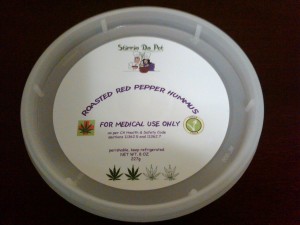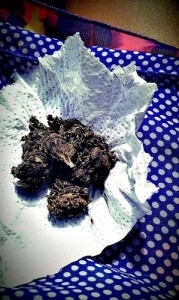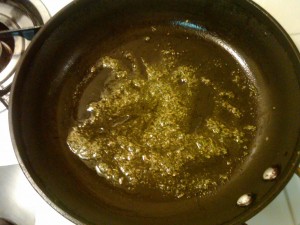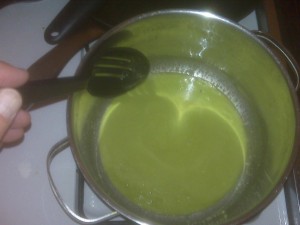As marijuana reaches higher levels of legality and semi-legality across the United States, an accompanying interest in, and knowledge about, ways in which the plant can be consumed has also increased.
Most Americans are familiar with the idea of pot brownies, those treats so ubiquitous in high school in college, made by mixing some cheap marijuana into boxed brownie batter. Some people have done a little research and discovered that the effect is more potent when the ground-up plant is added to a pan of hot butter, then combined with water, allowing the most potent part of the mix to rise to the top, where it is then strained, cooled and used in recipes where any fat is called for.
And for people who consume marijuana as medicine instead of a recreational activity, properly prepared cannabis is less of a joke and more of a necessity.
Eaten, Not Smoked
A marijuana grower in Washington state explains what many of us have heard anecdotally: marijuana eaten takes longer to kick in than its smoked counterpart, but the effect lasts much longer. “Someone could have a breakfast sandwich with pot pesto in the morning, and still be hungry in the afternoon.” This distinction is important for ill people who have lost their appetite, which saps their strength and makes it difficult to keep down their medications.
(This Washington state grower’s family business is legal, but he doesn’t wish to publicize it, given his other, more corporate day job.)
“It’s also helped patients that the products themselves have become more substantial, and have more healthy calories,” he says. Recently, he’s seen an increase in items like refrigerated, take-home lasagnas at dispensaries he works with; a friend of his, ill with cancer, gained 30 pounds in about eight weeks after discovering cannabis burritos at her new dispensary.
An informal, small-scale poll done for this article showed that no one really enjoys the taste of marijuana on its own. Sure, the flavor can trigger some nostalgic or positive Pavlovian feelings, but would anyone choose to add the flavor, but not the effects, of marijuana to their meals? To a man, the answer is no.
Accordingly, it’s used pretty strictly as an herbal addition, never as a vegetable or side dish on its own. Bobby Greig, chef and owner at Greig Edibles Inc. in California, started his professional kitchen after his father was diagnosed with cancer. With every recipe he tries, the goal is two-fold: make something delicious, and mask the marijuana flavor entirely.
Sure, the flavor can trigger some nostalgic or positive Pavlovian feelings, but would anyone choose to add the flavor, but not the effects, of marijuana to their meals? To a man, the answer is no.
“Marijuana’s really a disgusting flavor, so I do a lot of bold flavors to hide it, like chili, mac and cheese, garlic mashed potatoes.” Before Greig started his business, he thought of marijuana edibles as novelty items, like a white chocolate pot bar he once ate, though he found it unappetizing. “The candy is okay for, say, a college kid, but for people with serious health problems, things like that are not enough.”
Still, Greig found that at many dispensaries, products more complicated than salsas and hummus never really found an audience. (He suspects that had a lot to do with employee enthusiasm at the dispensaries, which seemed reserved for snacks and desserts.) Now, his company more often delivers to homes and hospices, where his plated dinners seem more appreciated.
Though many of Greig’s recipes are hearty, his experience has enabled him to customize meals for his clients. For instance, his diabetic clients will likely order vinaigrettes and other dressings, and Greig has developed methods for infusing olive oil with cannabis, for recipes where butter isn’t the best fit. (This method is great for combining other seasonings, making, for instance, a garlic-rosemary-cannabis infused oil.) “I’m a chef, so I can figure out a way to incorporate cannabis into any recipe,” he says.
Different strains, though they produce different effects in users, don’t seem to have different flavors. In cooking, they’re chosen not for taste but for result, with indica for people who want to sleep, and sativa for people who have to remain alert.
“I make normal, great tasting food: it’s medicated, but you wouldn’t even know it from the taste, says Greig. “My macaroni is made with four smoked cheeses, with the medicine added to the roux: the green gets completely cooked out. Or, I just mix it in with the panko topping.”
Grass-Fed Movement
As the move to legalize marijuana gains favor, more and more people are treating it as an industry that needs regulation. Food Laws for Marijuana Dispensaries is a Rhode Island-based group that wants to implement USDA-style labeling on prepared, marijuana-laced food.  The group’s founder, Topher Seal, says that since sick people are the main consumers of cannabis goods, it’s important that ingredients be listed to protect against allergies and counter-indications. Of course, It’s also possible to make your own cannabis foods at home: Seal himself enjoys banana nut muffins and popcorn, which has a subtle green sheen that appeals to his senses.
The group’s founder, Topher Seal, says that since sick people are the main consumers of cannabis goods, it’s important that ingredients be listed to protect against allergies and counter-indications. Of course, It’s also possible to make your own cannabis foods at home: Seal himself enjoys banana nut muffins and popcorn, which has a subtle green sheen that appeals to his senses.
Greig believes that this new emphasis on real food is “a natural progression” in the path towards marijuana acceptance. More people are consuming it, so the demands are becoming more varied. There’s no denying that at many Southern California dispensaries, freshly-made morning donuts from Wake & Bake Fresh Edibles are the most sought-after item. But for those whose marijuana consumption is about pain and anxiety relief, chefs like Bobby Greig are almost as important as the drug itself.
(Banner photo © Rob Alberola)



Katherine,
I apologize for not responding sooner, life has a way of doing it’s thing. I’m so sorry we’ve missed the deadline. I’m just very glad I got your message on facebook and hope we can work together in the future.
My partner and I are patients and edibles users. We’re getting a website up and running that will enable patients to get info on the edibles they’re eating and track down their favorite products. We’re really pushing for standards, removing the stigma of being a patient, providing resources for patients and vendors, finding ways for patients to get their meds without adding extra calories or smoking, etc. We want to evolve the site based on the needs of the patients. We’ve done some serious research on extraction methods and cooking with cannabis, the laws, strains and uses for various diseases.
I love that you are a culinary journal! I’m so glad you were able to talk to some of the edibles vendors that were commercial bakers before they became medical marijuana vendors.
I would love to work on a follow up with you do one. If you get requests for recipes, please send readers to http://www.edibleslist.com. We should have the recipes up soon.
I’m sorry I missed the chance to work with you and hope to have another opportunity in the future.
Debbie Ashlock
The Edibles List